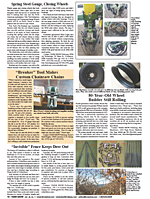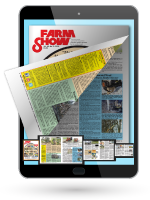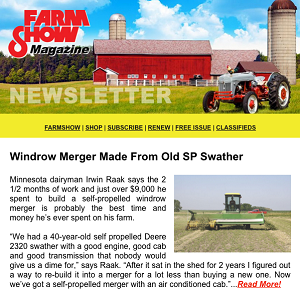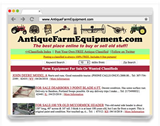2016 - Volume #40, Issue #1, Page #40
[ Sample Stories From This Issue | List of All Stories In This Issue | Print this story
| Read this issue]
Car Headlights Used To Light Cattle Shed
Walk into one end of K.D. Cook’s custom built cattle shed when the lights are on and you might think you’re face-to-face with a half dozen cars. That’s because Cook used a dozen old car headlights to illuminate the inside of his building. They all mount at one end of the shed facing the other end.“I decided to use old sealed beam car headlights in the shed rather than mercury vapor because they’re instant-on and they’d throw out plenty of light when I was working the cattle,” says Cook. “I bought them for a buck or two, so the price was right. Then I went to an auto store and bought plugs so I could wire them in sequence.”
Cook mounted each headlight to a metal roof truss on a piece of 18-in. long angle iron. Each headlight is held inside a plastic flower pot with a small metal bracket so it faces out instead of down. Initially he wired all of the lights in sequence to one switch and connected it through a 20-amp fuse, but that wasn’t large enough. “Whenever I flipped the switch, the fuse blew, so I went to Plan B,” says Cook.
He tried powering the lights through transformers from old welders, but they put out too much power. What did work was running power through a 200-amp battery charger with 10 amp, 30 amp and 40 amp output settings. With the dial on 40 amps it runs all the lights. He uses 3 switches to turn the ones he needs on and off. Better yet, if the utility power is out, Cook says he can hook up the charger’s battery cables to his tractor and still have lights in his shed.
Another unique feature of Cook’s shed is the 5-ft. tall inner wall made of metal roadside guardrails. Three horizontal metal rails are welded to the vertical metal upright posts with a small space between. Cook says the smooth rail surface provides a nice protective wall for the cattle and keeps them from pushing out metal side panels.
His 80-acre hillside farm has 60 acres of pasture divided into 17 paddocks of 3 to 6 acres each. He grazes 60 to 80 beef cattle about two thirds of the year. He waters the cattle using a 3,000-gal. reservoir he built on the hillside, 150 ft. above the well-head. Gravity flow feeds water troughs that serve the paddocks. He uses the shed to work the cattle as needed and for loadout when they’re ready for market.
“My acreage was part of our family farm, and I’m proud to have it set up with rotational grazing and a nice building I put up myself to work the cattle,” says Cook.
Contact: FARM SHOW Followup, K.D. Cook, 206 Old Fincastle Road, Lebanon, Virginia 24266 (ph 276 889-1158).

Click here to download page story appeared in.

Click here to read entire issue
To read the rest of this story, download this issue below or click here to register with your account number.



